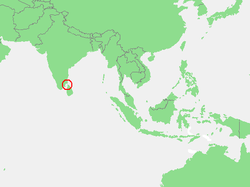Gulf of Mannar
| Gulf of Mannar மன்னார் வளைகுடா මන්නාරමි බොක්ක |
|
|---|---|
 |
|
 |
|
| Location | Tamil Nadu |
| Coordinates | 8°28′N 79°01′E / 8.47°N 79.02°ECoordinates: 8°28′N 79°01′E / 8.47°N 79.02°E |
| Basin countries | India, Sri Lanka |
| Max. length | 160 km (99 mi) |
| Max. width | 130–275 km (81–171 mi) |
| Surface area | 10,500 km2 (4,100 sq mi) |
| Average depth | 1,335 m (4,380 ft) |
| References | |
The Gulf of Mannar is a large shallow bay forming part of the Laccadive Sea in the Indian Ocean. It lies between the southeastern tip of India and the west coast of Sri Lanka, in the Coromandel Coast region.
A species known as dugong (sea cow) is found here.
The chain of low islands and reefs known as Ramsethu, also called Adam's Bridge, which includes Mannar Island, separates the Gulf of Mannar from Palk Bay, which lies to the north between India and Sri Lanka. The estuaries of Thamirabarani River of South India and the Malvathu Oya (Malvathu River) of Sri Lanka drain into the Gulf.
Located on the southeastern tip of the subcontinent, the Gulf of Mannar is known to harbour over 3,600 species of flora and fauna, making it one of the richest coastal regions in Asia. 117 hard coral species have been recorded in the Gulf of Mannar. Sea turtles are frequent visitors to the gulf as are sharks, dugongs, and dolphins. However, the combined effects of 47 villages, with a total population of around 50,000 has meant that overharvesting of marine species has become a problem. The decline of fish populations has been accompanied with reducing numbers of pearl oyster, gorgonian coral, and acorn worm. Local fishermen rely on the reef to feed their families, but destructive fishing methods combined with the stress of pollution and coral mining have meant both nearshore and offshore catches have decreased. Endangered species include dolphins, dugongs, whales and sea cucumbers.
...
Wikipedia
